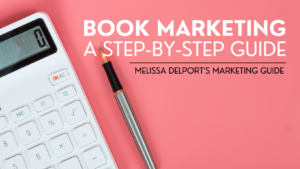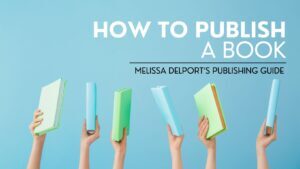Melissa Delport's Blog
November 26, 2024
The Inciting Incident and How to Use the Narrative Hook
If there’s one thing I have learned in my decade of authorship, it’s that readers can be ruthless. We are spoilt for choice when it comes to entertainment options, and as authors, we are pitching to a population that is easily distracted by their phones and screens, so it is imperative that we hook a reader’s attention as early as possible, and then keep them on the line as our story progresses.
This is where the inciting incident and the narrative hook become your secret weapons and as part of my writing guide, I’m going to teach you how to use them.
But what exactly is the narrative hook, or the inciting incident, you ask? And more importantly, how can you wield them effectively? Let’s dive into the mechanics of storytelling and these crucial elements – how they differ, how they work, and how you can use them to level up your writing.
What is a Narrative Hook?Much like it sounds, the narrative hook is the bait that you dangle into the reader pool. It is the opening sentence, paragraph or page that is designed to pique your reader’s interest and convince them to keep reading. The purpose of the narrative hook is simple and self-explanator: to hook the reader. It should raise questions or trigger a strong emotional response.
That being said, the narrative hook isn’t meant to just intrigue the reader – it also sets the tone for your entire story. It gives your reader a taste of what is to come and sets their expectations.
Good Narrative Hook Examples:“It was a bright cold day in April, and the clocks were striking thirteen.” – 1984 by George Orwell.
As far as opening lines goes, this is a great one. It immediately poses questions: Clocks do not strike thirteen, so what world is this, and how is it normal? The strangeness of that concept drives a reader to explore further.
“If you’re going to read this, don’t bother.” – Choke by Chuck Palahniuk
This sentence is unusually defiant, and intrigues the reader, laying down a challenge without preamble.
“There was a hand in the darkness, and it held a knife.” – The Graveyard Book by Neil Gaiman
Hello, immediate suspense! Who does this hand belong to? What ill-intent is planned? This anticiption of danger or conflict will have the reader scrambling to turn the next page.
It is important to note that these narrative hooks are effective without giving anything away. Instead, they invite the reader to keep reading, to discover the answers they now crave.
What is an Inciting Incident?Where the narrative hook aims to draw readers in, the inciting incident is what sets the story in motion (don’t worry if you dont yet understand the difference, I will give you clear examples below!) The inciting incident is the catalyst – the point where the character’s life is disrupted and the protagonist’s story begins.
It usually occurs early on in the story – most commonly within the first chapter, and it introduces the central conflict (and often, the antogonist).
Inciting Incident ExamplesThe Hunger Games by Suzanne Collins: Katniss volunteers as tribute in place of Prim (her sister). This is the moment that Katniss is flung into her cental conflict – her fight for survival in the Hunger Games arena.
Harry Potter and the Philosopher’s Stone by J.K. Rowling: Harry gets his Hogwarts letter. This incident puts a permanent end to Harry’s life as a ‘muggle’ and introduces the magical world.
The Great Gatsby by F. Scott Fitzgerald: Nick Carraway moves to West Egg and becomes neighbors with Jay Gatsby. While this move might not seem that big of a deal, it’s the trigger for Nick to become involved in Gatsby’s world, which ultimately leads to the tragic events that unfold.
The inciting incident doesn’t have to be dramatic – it’s not called the ‘exciting’ incident. It can be as subtle as a chance meeting, or a simple decision – so long as it forces the main character to react, which in turn sets the plot in motion.
How the Narrative Hook and the Inciting Incident Work TogetherWhile each is distinct, these two elements work in tandem to create a gripping story opening. The hook grabs the reader’s interest, and the incident ensures they stay interested.
For example:
In The Hunger Games, the narratibe hook is Katniss hunting in the woods. This action establishes her resourcefulness while highlighting her harsh world. Then she volunteers as tribute (the inciting incident) and the reader is pulled fully into the conflict and the high-stakes scenario.
In Pride & Prejudice by Jane Austen, the hook is the opening line: “It is a truth universally acknowledged, that a single man in possession of a good fortune, must be in want of a wife.” It sets the tone for the themes of love, class and marriage that the book is famous for. The inciting incident, on the other hand, occurs when Mr Bingley and Mr Darcy arrive in the neighborhood – which disrupts the status quo and sets the stage for the Bennett sisters’ romantic entanglements.
How to Write a Good Narrative Hook: Start with a question or mystery: if you open with something unusual or unexplained, your reader will want to keep reading to get to the bottom of it and have their curiosity sated. Evoke Emotion: be it fear, joy, sadness or anger – emotions draw the reader in!Throw the Reader into Action: Start in the middle of a scene to create immediate engagement. How to Write a Good Inciting IncidentIndentify the Core Conflict: the inciting incident should always introduce the problem or challenge at the heart of the story. Make it Personal: the inciting incident should directly affect your protagonist and force them to make a choice or take action. Create Irreversible Change: Ensure that the protagonist can’t just return to the way things were – the status quo must be changed and a new reality created. Make it Early: Readers don’t want to wait too long for the story to get going. Make sure your inciting incident is within the first few chapters. Mistakes to AvoidWaiting too Long: Like I mentioned at the very beginning of this article, readers can be ruthless They might lose their patience if your story is meandering without any clear direction or purpose. A Confusing Hook: if your opening hints at a breakneck thriller, don’t follow it up with a slow paced romance. A Complicated Hook: don’t overcomplicate things or try to be too clever. You could lose your reader. A strong hook can be simple but effective.
They might lose their patience if your story is meandering without any clear direction or purpose. A Confusing Hook: if your opening hints at a breakneck thriller, don’t follow it up with a slow paced romance. A Complicated Hook: don’t overcomplicate things or try to be too clever. You could lose your reader. A strong hook can be simple but effective. The combination of a strong narrative hook and a strong inciting incident is the dynamic duo of storytelling. The hook grabs your reader by the collar while the inciting hook keeps them invested and draws them into the heart of your tale. If you manage to master both of these elements, you will ensure that you book not only starts with a bang, but is also impossible to put down.
Can the narrative hook and the incitiing incident happen at the same time?Yes, the two can overlap, but its not common. An example would be The Martian, where the opening line serves as both the narratove hook and the inciting incident.
Can a book have more than one inciting incident?No. A book can have several exciting incidents, there is only typically only one main inciting incident that kicks off the central conflict. An exception would be a stpry told in multiple POV, where each character might have their own inciting incident.
The post The Inciting Incident and How to Use the Narrative Hook appeared first on Melissa Delport.
November 20, 2024
Best Newsletter Software for Authors

The post Best Newsletter Software for Authors appeared first on Melissa Delport.
November 14, 2024
Social Media for Authors: An Essential Guide

The post Social Media for Authors: An Essential Guide appeared first on Melissa Delport.
November 13, 2024
How to Market a Book: a Step-by-Step Guide

The post How to Market a Book: a Step-by-Step Guide appeared first on Melissa Delport.
November 12, 2024
How to Write Backstory Effectively

The post How to Write Backstory Effectively appeared first on Melissa Delport.
October 16, 2024
The Dreaded Middle: Pushing through your book’s midpoint.

The post The Dreaded Middle: Pushing through your book’s midpoint. appeared first on Melissa Delport.
October 15, 2024
How to Publish a Book: A Step-by-Step Guide

The post How to Publish a Book: A Step-by-Step Guide appeared first on Melissa Delport.
September 26, 2024
The Difference Between a Radio Play and a Screenplay

The post The Difference Between a Radio Play and a Screenplay appeared first on Melissa Delport.
How to Write a Radio Play in Six Steps

The post How to Write a Radio Play in Six Steps appeared first on Melissa Delport.
September 24, 2024
Example of the Format of a Radio Play Script




